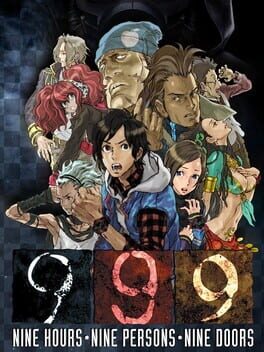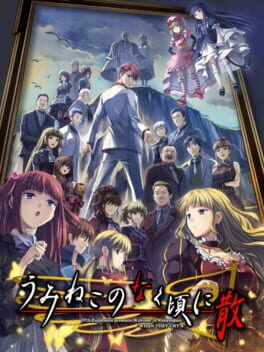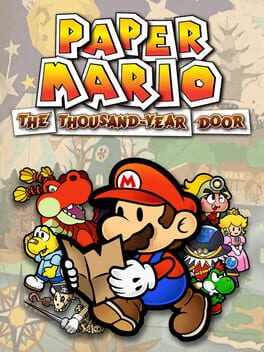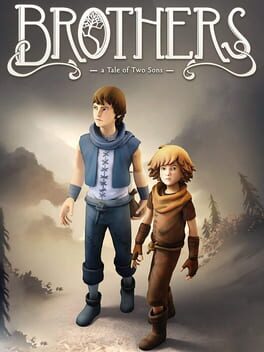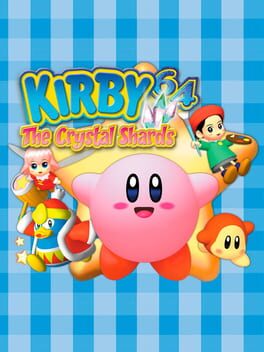frogyfro
Bio
i like weird games
i like weird games
Badges

1 Years of Service
Being part of the Backloggd community for 1 year

Shreked
Found the secret ogre page

Liked
Gained 10+ total review likes

Noticed
Gained 3+ followers

N00b
Played 100+ games
Favorite Games
238
Total Games Played
000
Played in 2024
000
Games Backloggd
Recently Reviewed See More
This review contains spoilers
If there's one game that perfectly encapsulates the advantage games have over other media, it might just be Brothers: A Tale of Two Sons. It's one thing see a empathize with a protagonist's struggles, witnessing them unfold in a book or a movie. The interactivity of games allows us to make those struggles our own.
There's no way to talk about Brothers without spoiling it, so here goes nothing. In Brothers, you control the two titular sons simultaneously: the left stick and trigger control the older brother, and the right stick and trigger control the younger brother. Several scenes of standard action-adventure unfold until, at the climax of the game, the older brother is mortally wounded, and dies from his injuries.
Now, we play as only the younger brother--left alone in the world. And we perceive this, playing with a stilted one-hand control scheme. The older brother's death is felt by the player, through the now useless left side of the controller.
Until of course, the younger brother reaches a creek he must cross to progress--in spite of his fear of water. You can walk the younger brother to the edge of the water and watch him refuse to enter, as he did throughout the game. Eventually, the player realizes that the younger brother can be encouraged, by pressing in the older brother's trigger. It's undoubtedly an impressive moment.
I found myself, after the older brother's passing, absentmindedly twirling the now lifeless left analog stick. Maybe this was my own form of denial. In it's own way, Brothers allowed me to experience the younger brother's loss along with him.
I think, though, the Brother's downfall is that, this moment of "mechanics as metaphor", as well-designed as it is, is all Brothers has to offer. You can tell Brothers was conceived as a mechanic first, as a game second, and as an story last. About all we really know about the two playable characters is written right there in the title.
The problem with this approach is that, the best metaphor means nothing if the characters it embodies aren't ones we care about. The controls enable us to empathize with the characters, but there is unfortunately nothing there for us to latch onto. Playing Brothers, I was emotionally moved, but because I thought back to my own experiences with loss, not the specific example Brothers actually depicts.
I said at the start that Brothers is the game most emblematic of what games as a medium can do that books and film cannot. But, Brothers falls short of actually putting its own concepts into action. Cereza and the Lost Demon is a game that probably took inspiration from Brothers. We control two characters simultaneously: the witch Cereza and the demon Cheshire. There is actually a similar moment to Brother's twist too: Cereza and Cheshire have an argument, leading to the two splitting up briefly. Playing with only one hand, we can feel Cheshire's absence.
There is no doubt Brothers did this concept better than Cereza and the Lost Demon. But it is the latter game that caused me more emotional resonance, simply because I actually cared about Cheshire, and I did not care about the older brother.
Brothers is undoubtedly a landmark title in our medium, but equally it is a cautionary tale. Brothers' commitment to its concept is admirable--but in doing so it loses sight of what really makes art matter.
There's no way to talk about Brothers without spoiling it, so here goes nothing. In Brothers, you control the two titular sons simultaneously: the left stick and trigger control the older brother, and the right stick and trigger control the younger brother. Several scenes of standard action-adventure unfold until, at the climax of the game, the older brother is mortally wounded, and dies from his injuries.
Now, we play as only the younger brother--left alone in the world. And we perceive this, playing with a stilted one-hand control scheme. The older brother's death is felt by the player, through the now useless left side of the controller.
Until of course, the younger brother reaches a creek he must cross to progress--in spite of his fear of water. You can walk the younger brother to the edge of the water and watch him refuse to enter, as he did throughout the game. Eventually, the player realizes that the younger brother can be encouraged, by pressing in the older brother's trigger. It's undoubtedly an impressive moment.
I found myself, after the older brother's passing, absentmindedly twirling the now lifeless left analog stick. Maybe this was my own form of denial. In it's own way, Brothers allowed me to experience the younger brother's loss along with him.
I think, though, the Brother's downfall is that, this moment of "mechanics as metaphor", as well-designed as it is, is all Brothers has to offer. You can tell Brothers was conceived as a mechanic first, as a game second, and as an story last. About all we really know about the two playable characters is written right there in the title.
The problem with this approach is that, the best metaphor means nothing if the characters it embodies aren't ones we care about. The controls enable us to empathize with the characters, but there is unfortunately nothing there for us to latch onto. Playing Brothers, I was emotionally moved, but because I thought back to my own experiences with loss, not the specific example Brothers actually depicts.
I said at the start that Brothers is the game most emblematic of what games as a medium can do that books and film cannot. But, Brothers falls short of actually putting its own concepts into action. Cereza and the Lost Demon is a game that probably took inspiration from Brothers. We control two characters simultaneously: the witch Cereza and the demon Cheshire. There is actually a similar moment to Brother's twist too: Cereza and Cheshire have an argument, leading to the two splitting up briefly. Playing with only one hand, we can feel Cheshire's absence.
There is no doubt Brothers did this concept better than Cereza and the Lost Demon. But it is the latter game that caused me more emotional resonance, simply because I actually cared about Cheshire, and I did not care about the older brother.
Brothers is undoubtedly a landmark title in our medium, but equally it is a cautionary tale. Brothers' commitment to its concept is admirable--but in doing so it loses sight of what really makes art matter.
The shift from 2D to 3D games was the biggest change the video games industry has ever seen (and possibly will ever see). Decades of established design needed to be rethought. It's not surprising this era brought with it major changes to the players in the industry: The birth of Sony and the death of Sega can at least partially be attributed to the PS1's strong lineup of early 3D classics, and Sega's haphazard translation of Sonic to 3D.
The point is, a huge part of why Nintendo maintained their presence in the industry is because of just how good Nintendo's early 3D titles were. Super Mario 64 and Ocarina of Time are more than just great games--they are so good, they made the transition to 3D look effortless.
This is why Kirby 64 is so fascinating. Kirby 64 is the only example of Nintendo seriously dropping the ball on the shift to 3D. Kirby 64 is more than just a mediocre game for the Nintendo 64. It gives us a view into an alternate timeline, one where Nintendo fumbled the transition to 3D games, and maybe even went the way of Sega.
It's especially surprising Kirby 64 is such a flop because... well... the game is hardly 3D. Kirby 64 is a 2.5D platformer. The game is rendered in full 3D, but the player's movement is restricted to a 2D axis. This ends up being the worst of both worlds. Kirby 64 gains almost nothing by presenting the player a 3D view. But, since rendering 3D environments is so graphically intensive, the dense levels of Kirby Superstar are not technically possible. The result is that Kirby 64's levels are barren wastelands compared to older Kirby games.
The combo transformations are actually a great concept. Kirby 64 has 35 different copy abilities, still the largest pool of any Kirby game to date. These are really fun to discover and experiment with: the resulting combination is always surprising, yet still makes perfect sense considering the reagents. Spark + Ice turning Kirby into a fridge is particularly memorable. Honestly, its amazing the execution of this concept is so strong, considering the rest of the game is such a slog.
This said, the level design seriously drops the ball on this concept. A great example of emergent design is the lightbulb power (bomb + spark) which can light up dark rooms. This is how Kirby 64's puzzles should have worked. Instead, most of the actual use of these copy abilities stems from colored blocks that require specific abilities to break. Not only is this a glorified lock-and-key, but it is completely impossible to know what power will be needed until the player reaches the block and it is already too late. This means that, if you want to actually collect the titular Crystal Shards, you're forced to play every stage twice. The stages usually aren't even fun the first time.
Anyway, Kirby 64 isn't all bad, but it seems to misunderstand what makes a 3D game great, and what makes a Kirby game great. In short, Kirby 64 isn't a horrible game, but it is no surprise Nintendo would wait another 20 odd years before attempting another 3D Kirby.
The point is, a huge part of why Nintendo maintained their presence in the industry is because of just how good Nintendo's early 3D titles were. Super Mario 64 and Ocarina of Time are more than just great games--they are so good, they made the transition to 3D look effortless.
This is why Kirby 64 is so fascinating. Kirby 64 is the only example of Nintendo seriously dropping the ball on the shift to 3D. Kirby 64 is more than just a mediocre game for the Nintendo 64. It gives us a view into an alternate timeline, one where Nintendo fumbled the transition to 3D games, and maybe even went the way of Sega.
It's especially surprising Kirby 64 is such a flop because... well... the game is hardly 3D. Kirby 64 is a 2.5D platformer. The game is rendered in full 3D, but the player's movement is restricted to a 2D axis. This ends up being the worst of both worlds. Kirby 64 gains almost nothing by presenting the player a 3D view. But, since rendering 3D environments is so graphically intensive, the dense levels of Kirby Superstar are not technically possible. The result is that Kirby 64's levels are barren wastelands compared to older Kirby games.
The combo transformations are actually a great concept. Kirby 64 has 35 different copy abilities, still the largest pool of any Kirby game to date. These are really fun to discover and experiment with: the resulting combination is always surprising, yet still makes perfect sense considering the reagents. Spark + Ice turning Kirby into a fridge is particularly memorable. Honestly, its amazing the execution of this concept is so strong, considering the rest of the game is such a slog.
This said, the level design seriously drops the ball on this concept. A great example of emergent design is the lightbulb power (bomb + spark) which can light up dark rooms. This is how Kirby 64's puzzles should have worked. Instead, most of the actual use of these copy abilities stems from colored blocks that require specific abilities to break. Not only is this a glorified lock-and-key, but it is completely impossible to know what power will be needed until the player reaches the block and it is already too late. This means that, if you want to actually collect the titular Crystal Shards, you're forced to play every stage twice. The stages usually aren't even fun the first time.
Anyway, Kirby 64 isn't all bad, but it seems to misunderstand what makes a 3D game great, and what makes a Kirby game great. In short, Kirby 64 isn't a horrible game, but it is no surprise Nintendo would wait another 20 odd years before attempting another 3D Kirby.
There's one truly inspired moment in Anodyne. I won't spoil it here, but it has to do with a context-sensitive action surprising the player with an unexpected outcome. I play games for moments like this: that catch me off guard and enlighten my understanding of game design. Overall, I feel pretty mixed on Anodyne, so I thought it best to start with the positive. Of every game I've rated below 2.5 stars, Anodyne is the one I'm most glad to have played, purely because of its willingness to surprise.
That said, Anodyne's downfall stems from how plain its inspirations are. Anodyne is Zelda meets Yume Nikki. This isn't necessarily a problem: Zelda and Yume Nikki are among the most influential, especially for indie games. The problem is, taking so much from such landmark titles invites a comparison that is seldom favorable.
Much like Zelda, Anodyne is a top down dungeon crawler. Anodyne's main innovation is using a Broom as a weapon: it functions much like a sword, but it has the added ability to pick up and place down dust. Unlike Zelda, there are no dungeon items, and few upgrades to speak of: every dungeon is designed entirely around the Broom. There are a few interesting puzzle solving applications of the broom: you can use dust to swim across water, or to block projectiles, or to power moving platforms. This central mechanic isn't horribly shallow, but it definitely lacks enough depth to support 6 dungeons. The result is, in spite of its short length, Anodyne feels quite repetitive, and easily wears out its welcome.
Much like Yume Nikki, Anodyne is an exploration-focused game taking place in the protagonists subconscious. Though I think Anodyne is a decent Zelda-like game, I really feel like it misses the mark on this front. Yume Nikki is gripping not just because of the surreal imagery, but because said imagery communicates something about the protagonist. Yume Nikki has a section that switches to an 8-bit art style--but this makes perfect sense considering Madotsuki owns a Famicom in the real world.
Anodyne also has a sudden 8bit section. But, what does this tell us about our protagonist, Young? Not much. After the 8-bit area, Anodyne drops all pretense and shoves the player into a Circus-themed dungeon for seemingly no reason.
Overall, Anodyne's setting captures all of the weaknesses of dreamlike settings, and none of the strengths. Anodyne feels incredibly lazy: It doesn't want to put in the work to establish a consistent setting, nor does it put effort into making its surreal imagery symbolically resonant like Yume Nikki does.
Ultimately, Anodyne blindly copies from Zelda and Yume Nikki, while embodying none of the lessons those games actually taught. It's not horrible, but its a long way from greatness.
That said, Anodyne's downfall stems from how plain its inspirations are. Anodyne is Zelda meets Yume Nikki. This isn't necessarily a problem: Zelda and Yume Nikki are among the most influential, especially for indie games. The problem is, taking so much from such landmark titles invites a comparison that is seldom favorable.
Much like Zelda, Anodyne is a top down dungeon crawler. Anodyne's main innovation is using a Broom as a weapon: it functions much like a sword, but it has the added ability to pick up and place down dust. Unlike Zelda, there are no dungeon items, and few upgrades to speak of: every dungeon is designed entirely around the Broom. There are a few interesting puzzle solving applications of the broom: you can use dust to swim across water, or to block projectiles, or to power moving platforms. This central mechanic isn't horribly shallow, but it definitely lacks enough depth to support 6 dungeons. The result is, in spite of its short length, Anodyne feels quite repetitive, and easily wears out its welcome.
Much like Yume Nikki, Anodyne is an exploration-focused game taking place in the protagonists subconscious. Though I think Anodyne is a decent Zelda-like game, I really feel like it misses the mark on this front. Yume Nikki is gripping not just because of the surreal imagery, but because said imagery communicates something about the protagonist. Yume Nikki has a section that switches to an 8-bit art style--but this makes perfect sense considering Madotsuki owns a Famicom in the real world.
Anodyne also has a sudden 8bit section. But, what does this tell us about our protagonist, Young? Not much. After the 8-bit area, Anodyne drops all pretense and shoves the player into a Circus-themed dungeon for seemingly no reason.
Overall, Anodyne's setting captures all of the weaknesses of dreamlike settings, and none of the strengths. Anodyne feels incredibly lazy: It doesn't want to put in the work to establish a consistent setting, nor does it put effort into making its surreal imagery symbolically resonant like Yume Nikki does.
Ultimately, Anodyne blindly copies from Zelda and Yume Nikki, while embodying none of the lessons those games actually taught. It's not horrible, but its a long way from greatness.

